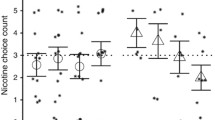Abstract
Antagonists of nicotine have been used in an attempt to resolve the continuing controversy about the role of nicotine as the primary reinforcer in cigarette smoking. Mecamylamine, an antagonist which readily penetrates to the central nervous system, increased the rate of cigarette smoking by about 30% in laboratory tests; this was accompanied by reduced blood pressure, impaired performance of a digit symbol substitution test, improved hand steadiness, and by dysphoria. The increased smoking may be regarded as self-titration with nicotine, an interpretation which receives some support from results obtained with pentolinium, an antagonist with predominantly peripheral actions. In the doses used, pentolinium did not affect smoking rate, blood pressure, or hand steadiness, but it impaired digit symbol performance and induced dysphoria. The different results with mecamylamine and pentolinium support previous evidence that the action of nicotine in the central nervous system has a small but clearly demonstrable role as a primary reinforcer of the smoking habit.
Similar content being viewed by others
References
Agué, C.: Nicotine content of cigarettes and the smoking habit: their relevance to subjective ratings of preferences in smokers. Psychopharmacologia (Berl.) 24, 326–330 (1972).
Asghar, K., Roth, L. J.: Entry and distribution of hexamethonium in the central nervous system. Biochem. Pharmacol. 20, 2787–2795 (1971).
Ashton, H., Watson, D. W.: Puffing frequency and nicotine intake in cigarette smokers. Brit. Med. J. 3, 679–681 (1970).
Clark, M. S. G.: Self-administered nicotine solutions preferred to placebo by the rat. Brit. J. Pharmacol. 35, 367 P (1969).
Clark, M. S. G., Rand, M. J., Vanov, S.: Comparison of pharmacological activity of nicotine and related alkaloids occurring in cigarette smoke. Arch. int. Pharmacodyn. 156, 363–379 (1965).
Deneau, G. A., Inoki, R.: Nicotine self-administration in monkeys. Ann. N. Y. Acad. Sci. 142, 277–279 (1967).
Dickens, D. W., Lader, M. H., Steinberg, H.: Differential effects of two amphetamine-barbiturate mixtures in man. Brit. J. Pharmacol. 24, 14–23 (1965).
Edwards, A. S.: The effects of smoking on tremor. J. appl. Psychol. 32, 150–158 (1948).
Federal Trade Commission: Report of “tar” and nicotine content of the smoke of 121 varieties of cigarettes. Washington, August 1971.
Finnegan, J. K., Larson, P. S., Haag, H. B.: The role of nicotine in the cigarette habit. Science 102, 94–96 (1945).
Frankenhaeuser, M., Myrsten, A.-L., Waszak, M., Neri, A., Post, B.: Dosage and time effects of cigarette smoking. Psychopharmacologia (Berl.) 13, 311–319 (1968).
Freis, E. D., Wilson, I. M.: Mecamylamine, a new, orally effective, hypotensive agent. Arch. intern. Med. 97, 551–561 (1956).
Frith, C. D.: The effect of varying the nicotine content of cigarettes on human smoking behaviour. Psychopharmacologia (Berl.) 19, 188–192 (1971).
Glick, S. D., Jarvik, M. E., Nakamura, R. K.: Inhibition by drugs of smoking behavior in monkeys. Nature (Lond.) 227, 969–971 (1970).
Goldfarb, T. L., Jarvik, M. E.: Accommodation to restricted tobacco smoke intake in cigarette smokers. Int. J. Addict. (in press).
Goldfarb, T. L., Jarvik, M. E., Glick, S. D.: Cigarette nicotine content as a determinant of human smoking behavior. Psychopharmacologia (Berl.) 17, 89–93 (1970).
Goodman, L. D., Gilman, A.: The Pharmacological Basis of Therapeutics, 4th Edit. New York: Macmillan 1970.
Izquierdo, I., Izquierdo, J. A.: Effects of drugs on deep brain centers. Ann. Rev. Pharmacol. 11, 189–208 (1971).
Jarvik, M. E.: The role of nicotine in the smoking habit, 155–190. In: Learning Mechanisms in Smoking, W. A. Hunt (ed.) Chicago: Aldine Pub. Co. 1970.
Jarvik, M. E.: Further observations on nicotine as the reinforcing agent in smoking. Proc. Conference on Motivation in Cigarette Smoking. St. Martin, Antilles (in press).
Jarvik, M. E., Glick, S. D., Nakamura, R. K.: Inhibition of cigarette smoking by orally administered nicotine. Clin. Pharmacol. Ther. 11, 574–576 (1970).
Larson, P. S., Silvette, H.: Tobacco: Experimental and clinical studies. Suppl. 1. Baltimore: Williams and Wilkins 1968.
Lucchesi, B. R., Schuster, C. R., Emley, G. S.: The role of nicotine as a determinant of cigarette smoking frequency in man with observations of certain cardiovascular effects associated with the tobacco alkaloid. Clin. Pharmacol. Ther. 8, 789–796 (1967).
Mirsky, A. F., Kornetsky, C.: On the dissimilar effects of drugs on the digit symbol substitution and continuous performance tests. Psychopharmacologia (Berl.) 5, 161–177 (1964).
Morrison, C. F., Goodyear, J. M., Sellers, C. M.: Antagonism by antimuscarinic and ganglion-blocking drugs of some of the behavioural effects of nicotine. Psychopharmacologia (Berl.) 15, 341–350 (1969).
Nowlis, V., Nowlis, H. H.: The description and analysis of mood. Ann. N. Y. Acad. Sci. 65, 345–355 (1956).
Paton, W. D. M.: The pharmacology of ganglion blocking agents, 365–375. In: Hypertension. J. H. Moyer (ed.) Philadelphia: W. B. Saunders Co. 1959.
Paton, W. D. M., Steinberg, H.: A class experiment on ganglion block in human subjects. Brit. med. J. 1956 II, 622–632.
Report of the Advisory Committee to the Surgeon General of the United States Public Health Service: Smoking and Health. P. H. S. Publication 1103 (1964).
Revusky, S., Garcia, J.: Learned associations over long delays, pp. 1–84. In: The psychology of learning and motivation, vol. 4. G. H. Bower (ed.). New York: Academic Press 1970.
Smirk, F. H., McQueen, E. G.: Use of mecamylamine in the management of hypertension. Brit. med. J. 1957 I, 422–425.
Stone, C. A., Meckelnburg, K. L., Torchiana, M. L.: Antagonism of nicotine-induced convulsions by ganglionic blocking agents. Arch. int. Pharmacodyn. 117, 419–434 (1958).
Wechsler, D.: The measurement of adult intelligence, 3rd Edit. Baltimore: Williams and Wilkins 1944.
Winer, B. J.: Statistical principles in experimental design. New York: McGraw-Hill 1962.
Wong, S., Long, J. P.: Antagonism of ganglionic stimulants by α,α′-bis-(dimethyl-ammoniumacetaldehyde diethylacetal)-p,p′-diacetylbiphenylbromide (DMAE). J. Pharmacol. exp. Ther. 164, 176–184 (1968).
Author information
Authors and Affiliations
Additional information
A preliminary account of this work has appeared previously (Jarvik, in press).
Rights and permissions
About this article
Cite this article
Stolerman, I.P., Goldfarb, T., Fink, R. et al. Influencing cigarette smoking with nicotine antagonists. Psychopharmacologia 28, 247–259 (1973). https://doi.org/10.1007/BF00429305
Received:
Revised:
Issue Date:
DOI: https://doi.org/10.1007/BF00429305




